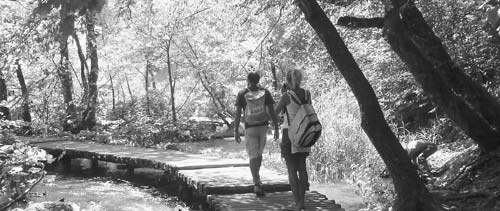
Nacionalni Park Plitvička Jezera
Map: Plitvice Lakes National Park
A Memorable Meal Surrounded by Waterfalls 30 Minutes North of Plitvice
Plitvice (PLEET-veet-seh) is one of Europe’s most spectacular natural wonders. Imagine Niagara Falls diced and sprinkled over a heavily forested Grand Canyon. There’s nothing like this lush valley of 16 terraced lakes, laced together by waterfalls, boat rides, and miles of pleasant plank walks. Countless cascades and water that’s both strangely clear and full of vibrant colors make this park a misty natural wonderland. Decades ago, after eight or nine visits, I thought I really knew Europe. Then I discovered Plitvice and realized you can never exhaust Europe’s surprises.
While Plitvice never fails to blow visitors away, a trip here brings you through one of the poorest, remotest areas of inland Croatia. This part of the country is still war-torn (bombed-out churches and homes you’ll see in many villages here most likely belonged to local Serbs who fled after the war), and the national park represents the only real industry for miles around. I find that many of the people in this region can be insular, a bit cranky, and overeager to catch their share of the tourist dollar. Public transportation is workable but far from slick, making this region best by car. Pack along a bit of patience; any hassles you encounter are well worth the feeling you’ll have when the spray from these amazing waterfalls caresses your face.
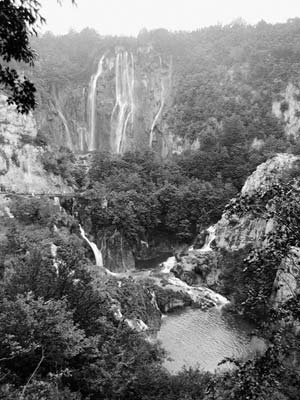
You can see all of the best scenery at Plitvice in just a three- to four-hour hike. While you can give yourself longer here, it’s not necessary. Other trails pale in comparison to this convenient main route.
Since it takes some time to get here (about two hours by car or bus from Zagreb), the most sensible plan is to spend the night in the area (either at one of the park’s hotels, or at a guest house nearby). If you’re coming from the north (e.g., Ljubljana), you can take the train to Zagreb in the morning, spend a few hours seeing the Croatian capital, then take the bus (generally no buses after about 16:00) or pick up a rental car and drive to Plitvice in the late afternoon. To avoid crowds, get up early and hit the trails (ideally by 8:30); by early afternoon, you’ll be ready to move on (south to the coast, or north to Zagreb). Two nights and a full day at Plitvice is probably overkill for all but the most avid hikers.
Crowd-Beating Tips: Plitvice is swamped with international tour groups, many of whom aren’t shy about elbowing into position for the best photos. While it’s impossible to avoid crowds entirely, you’ll get at least some of the park to yourself if you hike early or late. The park’s trails are most crowded between 10:00 and 15:00. I try to hit the trails by 8:30 and begin with the Lower Lakes; that way, the crowds are moving in just as I’m finishing up. If arriving in the afternoon, starting the hike after 15:00 also works well (though off-season, be careful to check when buses and boats stop running). The Upper Lakes are often less crowded later in the day, especially in the afternoon.
Plitvice Lakes National Park, a few miles from the Bosnian border, is located on the old highway between Zagreb and Split. While driving is the easiest option, it’s also reachable by bus.
If taking a bus to Plitvice, confirm schedules locally or online, and also confirm that your bus will actually stop at Plitvice. The park’s official bus stop is along the main road, about a 5- to 10-minute walk from the hotels.
By car, Plitvice is two hours south of Zagreb on the old highway #1 (a.k.a. D-1). Leaving Zagreb, take the A-1 expressway south for about an hour, exiting at Karlovac (marked for 1 and Plitvice). From here, D-1 takes you directly south about another hour to the park (see “En Route,” later). If you’re staying at the park hotels, you can park for free at the hotel lot; to park at the lots at Entrance 1 or Entrance 2, you’ll have to pay. For information about driving onward from Plitvice, see “Route Tips for Drivers” at the end of this chapter.
Buses leave from Zagreb’s main bus station in the direction of Plitvice (trip takes 2-2.5 hours). Various bus companies handle the route; the best option is an express bus that runs daily in summer, operated by a local company, Prijevoz Knežević (departs Zagreb 8:15, arrives Plitvice 10:20, late June-early Sept only, confirm schedule at www.prijevoz-knezevic.hr; also see here. If they won’t sell you a ticket for the Prijevoz Knežević express at the main ticket window, ask at the window for “Croatia Zovko Bus.” If the express doesn’t suit your schedule, you can just go to any ticket window and ask for the next departure. Non-express buses run from Zagreb about hourly until about 16:00; avoid the sporadic late-night buses, which don’t get you to the park until after midnight (for schedules, see www.autobusni-kolodvor.com or www.akz.hr; look for “Plitvička Jezera”).
En Route: By car or bus, you’ll see some thought-provoking terrain between Zagreb and Plitvice. Exiting the expressway at Karlovac, then heading south on D-1, you’ll pass through the village of Turanj—part of the war zone from two decades ago. Notice the military museum (on the right as you drive through), with tanks, heavy-artillery cannons, and other war machines that actually saw action. The destroyed, derelict houses belonged to Serbs who have not come back to reclaim and repair them. Farther along, about 25 miles before Plitvice, you’ll pass through the striking village of Slunj, perched picturesquely on travertine formations (like Plitvice’s) and surrounded by sparkling streams and waterfalls. The most traditional part of the town, perched just above the water, is called Rastoke, which has a memorable restaurant (see here). If you’re driving, this is worth a photo stop. This town, too, looks very different from how it did before the war—when it was 30 percent Serb. As in countless other villages in the Croatian interior, the Orthodox church has been destroyed...and locals still seethe when they describe how the Serbs “defiled” the town’s delicate beauty.
Drivers head north on the A-1 expressway, exiting at Gornja Ploča; from here, you’ll follow road D-1 about an hour north (passing Udbina and Korenica) to the park.
Two daily express buses run from Split to Plitvice in summer (departing 15:30 late June-late Sept, with additional departure at 10:15 July-Aug, 4-4.5 hours, operated by Prijevoz Knežević, www.prijevoz-knezevic.hr; also see schedule on here). Many other non-express options run a similar route (about 7-8/day in summer, 4/day in winter, 4-6 hours).
Plitvice’s 16 lakes are divided into the Upper Lakes (Gornja Jezera) and the Lower Lakes (Donja Jezera). The park officially has two entrances (ulaz), each with ticket windows and snack and gift shops. Entrance 1 overlooks the bottom of the Lower Lakes. Entrance 2 is about 1.5 miles south, near the cluster of Plitvice’s three hotels (Jezero, Plitvice, and Bellevue; see “Sleeping in and near Plitvice,” later). There is no town at Plitvice. The nearest village, Mukinje, is a residential community mostly for park workers.
Cost: The price to enter the park varies by season: 180 kn July-Aug, 110 kn April-June and Sept-Oct, and 55 kn Nov-March. This price covers park entry, boat, and shuttle bus. Park hotel guests pay the entry fee only once for their entire stay; if you’re staying off-site and want to visit the park on several days, you’ll have to buy separate tickets each day.
Hours: The park is open every day, but the hours vary by season. In summer, it’s generally open 7:00-20:00; in spring and fall, 8:00-18:00; and in winter, 8:00-16:00. The last boats and shuttle buses depart earlier (generally 30-60 minutes before the park closes—if hiking late in the day, ask about this before you head out). The quick boat ride between P-1 (below the hotels) and P-2 (at the Upper Lakes) runs later. Again, for fewer tour-group crowds, visit early or late in the day.
Services: While you’ll find WCs at both entrances, once you’re on the trails, they’re quite rare: The only convenient one is near the P-3 boat dock (the Kozjak Lake boat dock for the Lower Lakes). There is no WC at the P-2 boat dock—the only WC at the Upper Lakes is at the ST-3 bus stop, at the very top of these lakes. Plan accordingly.
A handy map of the trails is on the back of your ticket, and big maps are posted all over the park. Unless you’re planning a more ambitious hike than the usual circuit I describe, I’d skip the big map and the various English-language guidebooks (both sold at entrances, hotels, and shops throughout the park). The park has a good website: www.np-plitvicka-jezera.hr.
Plitvice is designed for hikers. But the park has a few other ways (included in entry cost) to help you connect the best parts.
By Shuttle Bus: Remember, buses connect the hotels at Entrance 2 (stop ST-2, below Hotel Jezero) with the top of the Upper Lakes (stop ST-3) and roughly the bottom of the Lower Lakes (stop ST-1, a 10-minute walk from Entrance 1). Buses start running early and continue until late afternoon (frequency depends on demand—generally 3-4/hour; buses run from March until the first snow—often Dec). Note that the park refers to its buses as “trains,” which confuses some visitors. Also note that no local buses take you along the major road (D-1) that connects the entrances. The only way to get between them without a car is by shuttle bus (inside the park) or by foot (about a 40-minute walk).
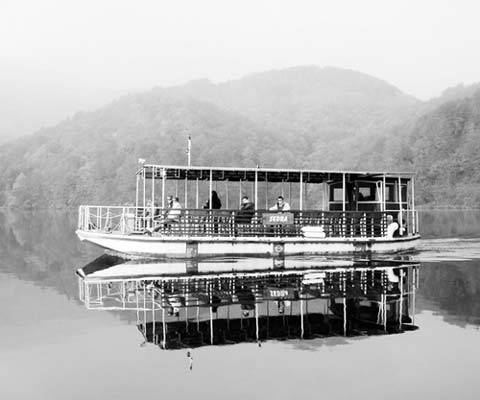
By Boat: Low-impact electric boats ply the waters of the biggest lake, Kozjak, with three stops: a steep hike below Entrance 2 and the park hotels (stop P-1), at the bottom of the Upper Lakes (P-2), and at the far end of Kozjak, at the top of the Lower Lakes (P-3). From Hotel Jezero to the Upper Lakes, it’s a quick five-minute ride; the boat goes back and forth continuously. The trip from the Upper Lakes to the Lower Lakes takes closer to 20 minutes, and the boat goes about twice per hour—often at the top and bottom of every hour. (With up to 10,000 people a day visiting the park, you might have to wait for a seat on this boat.)
Plitvice is a refreshing playground of 16 terraced lakes, separated by natural travertine dams and connected by countless waterfalls. Over time, the water has simultaneously carved out, and, with the help of mineral deposits, built up this fluid landscape.
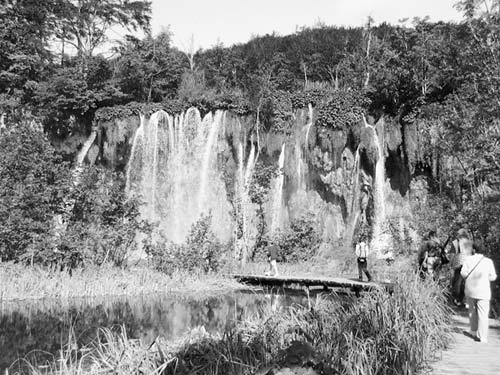
Plitvice became Croatia’s first national park in 1949, and was a popular destination during the Yugoslav period. On Easter Sunday in 1991, the first shots of Croatia’s war with Yugoslavia were fired right here—in fact, the war’s first casualty was a park policeman, Josip Jović. The Serbs held Plitvice until 1995, and most of the Croatians you’ll meet here were evacuated and lived near the coast as refugees. During those five years, the park saw virtually no tourists, and was allowed to grow wild—allowing the ecosystem to recover from the impact of so many visitors. Today, the war is a fading memory, and the park is again a popular tourist destination, with nearly a million visitors each year (though relatively few are from the US).
Plitvice’s system of trails and boardwalks makes it possible for visitors to get immersed in the park’s beauty. In some places, the path leads literally right up the middle of a waterfall. The official park map and signage recommend a variety of hikes, but there’s no need to adhere strictly to these suggestions if you want to create your own route.
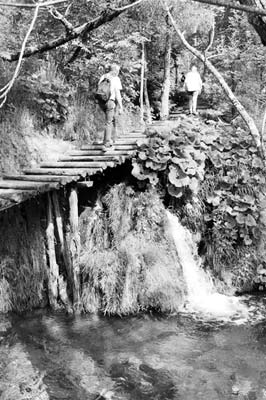
Planning Your Time: Most visitors stick to the main paths and choose between two basic plans: uphill or downhill. Each one has pros and cons. Park officials generally recommend hiking uphill, from the Lower Lakes to the Upper Lakes, which offers slightly better head-on views of the best scenery (this is the route described below). It also saves the most scenic stretch of lakes and falls—the Upper Lakes—for last. If you get an early start, going in this direction helps keep you in front of the crowds. Hiking downhill, from Upper to Lower, is easier (though you’ll have to hike steeply up out of the canyon at the end), and since most groups go the opposite way, you’ll be passing—but not stuck behind—the crowds. (Regardless of where and when you go, you won’t be able to avoid the crowds entirely.)
Walking briskly and with a few brief photo stops, figure at least an hour for the Lower Lakes, about an hour for the Upper Lakes, and a half-hour to connect them by boat—though it can take longer than this when the park is crowded, which it often is.
The lower half of Plitvice’s lakes are accessible from Entrance 1. If you start here, the route marked B leads you along the boardwalks to Kozjak, the big lake that connects the Lower and the Upper Lakes (described later).
From the entrance, you’ll descend a steep path with lots of switchbacks, as well as thrilling postcard views over the canyon of the Lower Lakes. As you reach the lakes and begin to follow the boardwalks, you’ll have great up-close views of the travertine formations that make up Plitvice’s many waterfalls. Count the trout. If you’re tempted to throw in a line, don’t. Fishing is strictly forbidden.
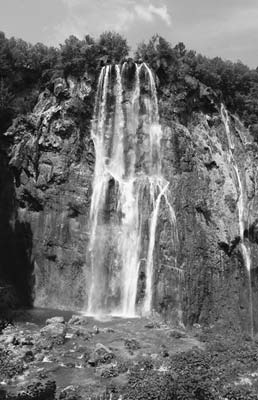
After you cross the path over the first lake, an optional 10-minute detour (to the right) takes you down to the Big Waterfall (Veliki Slap). It’s the biggest of Plitvice’s waterfalls, where the Plitvica River plunges 250 feet over a cliff into the valley below. Depending on recent rainfall, the force of the Big Waterfall varies from a light mist to a thundering deluge.
If you’re a hardy hiker, consider climbing the steep steps from the Big Waterfall up to a viewpoint at the top of the canyon (marked Sightseeing Point/Vidikovac; it’s a strenuous 10-minute hike to the top). Take the stairs up, bearing to the right at the top (near the shelter) to find a nice viewpoint overlooking the Big Waterfall. From here, you can carry on along the road that actually goes up over the top of the Big Waterfall, offering more views over the park. (Go as far as you like, then return the way you came.) The giant mill perched at the top of the Big Waterfall was used to grind grains; this very poor part of Croatia was traditionally inhabited by farmers.
When you’re done at the Big Waterfall, backtrack up to the main trail and continue on the boardwalks. You’ll skirt the rim of Kaluđerovac Lake; then, after you pass another bank of waterfalls, a smaller trail branches off (on the left) toward Šupljara (“Bottomless”) Cave. You can actually climb through this slippery cave all the way up to the trail overlooking the Lower Lakes (though it’s not recommended). This unassuming cavern is a big draw. In the 1960s, several German and Italian “Spaghetti Westerns” were filmed at Plitvice and in other parts of Croatia (which, to European eyes, has terrain similar to the American West). The most famous, Der Schatz im Silbersee (The Treasure in Silver Lake), was filmed here at Plitvice, and the treasure was hidden in this cave. The movie—complete with Deutsch-speaking “Native Americans”—is still a favorite in Germany, and popular theme tours bring German tourists to movie locations here in Croatia. (If you drive the roads near Plitvice, keep an eye out for strange, Native American-sounding names such as Winnetou—fictional characters from these beloved stories of the Old West, by the German writer Karl May.)
After Šupljara Cave, you’ll stick to the east side of Gavanovac Lake, pass some picturesque terraces, then walk along the shore of Milanovac Lake, before crossing over one more time to the west, where you’ll cut through a comparatively dull forest. You’ll head up the paved road, branching off to the left (following the boat icon) to emerge at a pit-stop-perfect clearing with WCs, picnic tables, a souvenir shop, and a self-service restaurant. Here you can catch the shuttle boat across Lake Kozjak to the bottom of the Upper Lakes (usually every 30 minutes).
The park’s biggest lake, Kozjak, connects the Lower and Upper Lakes. The 20-minute boat ride between Plitvice’s two halves offers a great chance for a breather. You can hike between the lakes along the west side of Kozjak, but the scenery’s not nearly as good as in the rest of the park.
Focus on the lower half of the Upper Lakes, where nearly all the exotic beauty is (between P-2 and Lake Galovac). You’ll soon experience some of the most striking waterfalls in the whole park. Enjoy the stroll, taking your time...and lots of photos.
Climbing up steeply on stepped boardwalks from the boat dock (following signs for C), you’ll pass deep pools with fallen trees stretching along the bottom, illustrating just how magnificently clear the water here is. Soon you’ll curl along the waterline of Gradinsko Lake. At the end of the lake, you’ll come to the park’s finest cascades, which tumble dramatically from Galovac into Gradinsko. You’ll hear the waterfalls, then you’ll see them, and finally you’ll feel them, as the spray pelts you while you stroll the boardwalks (careful—cover your camera). First you’ll pass by thundering Veliki (“Big”) Prštavac, then hook up a tight-and-steep uphill bend—literally walking in the middle of a waterfall—to the nearly as spectacular Mali (“Small”) Prštavac. Then you’ll stroll along a whole wall of other waterfalls. Continuing up, you’ll weave through another grand set of pools and falls, with views down on the pond of Galovački Buk. Walk along here, enjoying more ponds and cascades. Eventually you’ll emerge at a fork in the path. Here, you have two options:
1. Make your hike a loop by turning left (following signs for the boat icon, P-2, and E, H, and K). This is the easiest and most enjoyable choice for most hikers. First, you’ll walk down a stepped boardwalk with gurgling water underfoot. Then you’ll circle back around the far (south) side of Gradinsko Lake and through a forest. Finally you’ll pass a small picnic shelter, then walk down past one last set of falls to the P-2 boat dock, where you can take the boat back over to the hotels (P-1 stop).
2. Turn right (following the icon for the shuttle bus and C) to continue hiking up to the top of the Upper Lakes. I’d choose this option only if you have energy and time to burn. This route leads you somewhat pointlessly along the top of the best waterfalls (heard, but not seen), then loops you the long way around the Galovac Lake and eventually to the ST-3 bus stop. From here on up, the scenery is less stunning, and the waterfalls are fewer and farther between. At the top, you’ll finish at shuttle bus stop ST-3 (with food stalls and a WC), where the bus zips you back to the entrances and hotels.
Nice work!
The most convenient way to sleep at Plitvice is to stay at the park’s lodges, which are all run by the same office (reservation tel. 053/751-015, www.np-plitvicka-jezera.hr, info@np-plitvicka-jezera.hr; reception numbers for each hotel listed below). Warning: Because of high volume in peak season, the booking office sometimes doesn’t respond to emails. Instead, to make a reservation, use the park’s website to book your room (look for the “Online booking” box). In a pinch, try calling the booking office or the hotel directly (they speak English). Note that none of these hotels has air-conditioning (which is rarely needed in this climate), and all of them include breakfast in their rates and have free Wi-Fi in the lobby.
$$$ Hotel Jezero is big and modern, with all the comfort—and charm—of a Holiday Inn. It’s well-situated right at the park entrance and offers 200 rooms that feel newish, but generally have at least one thing that’s broken. Rooms facing the park have big glass doors and balconies (Sb-€83/€76/€61, Db-€118/€108/€86; elevator, reception tel. 053/751-400).
$$ Hotel Plitvice, a better value than Jezero, offers 57 rooms and mod, wide-open public spaces on two floors with no elevator. For rooms, choose from economy (fine, older-feeling; Sb-€72/€65/€50, Db-€96/€82/€70), standard (just a teeny bit bigger; Sb-€77/€70/€55, Db-€106/€96/€74), or superior (bigger still, with a sitting area; Sb-€82/€75/€60, Db-€116/€106/€84, reception tel. 053/751-100).
$$ Hotel Bellevue, dated and faded, feels like a Tito-era leftover, with a musty orange-and-dark-brown color scheme in its 77 rooms. While not up to the standards of the other park hotels, it’s cheap (Sb-€55/€50/€40, Db-€74/€68/€54, no elevator, closed Nov-March, reception tel. 053/751-700).
While the park’s lodges are the easiest choice for non-drivers, those with a car should consider sleeping at one of the many other options near the park. Prices here are likewise high, but the accommodations recommended below at least offer a bit more personality.
Dozens of mid-size hotels and small sobe line the highway for about 10 miles north of the national park. Options are so abundant here that spontaneous travelers can simply show up without reservations and take their pick. I’ve listed some favorites below. To reach Plitvička Sedra and Tina, turn left off the main road toward Bihać, after entering the town of Rakovica. The Degenija is right along the main road, a bit closer to Plitvice.
$$$ Hotel Degenija is a bit too pricey, but offers all of the big hotel comforts in a homier package than the park lodges. Its 20 modern, stylish rooms are in a building behind the bustling roadside restaurant (economy Db-€93/€84/€78, comfort Db-€110/€92/€85, superior Db-€115/€97/€90, bigger suites also available, air-con, elevator, free Wi-Fi, Selište Drežničko 57a, tel. 047/782-143, www.hotel-degenija.com, rezervacije.degenija@email.t-com.hr). The busy restaurant is justifiably popular with tour groups (30-50-kn pastas and pizzas, 65-90-kn main courses, daily 7:00-23:00).
$$ Villa Plitvička Sedra may be the best value around. It’s a homey yet modern-feeling, stone-and-wood complex that sits in a pleasant parklike setting, with tennis courts and a billiards pavilion, just off the main road. The 22 rooms have all the comforts you’ll need for an overnight near the park (standard Db-€55/€40, larger superior Db with balcony-€70/€65, air-con, free guest computer and Wi-Fi, Irinovac 149, tel. 047/784-401, www.restoran-sedra.hr, info@restoran-sedra.hr). The restaurant is also inviting (35-80-kn meals, open long hours daily).
$ House Tina is a neon-yellow farmhouse surrounded by fields (and a dozen other B&Bs) just off the main road. They have 11 rooms, including two nicely woody bungalows that sleep four each (Db-€60/€50/€45, bungalow-€96/€88/€80, studio apartment-€120/€100/€90, some with air-con, free Wi-Fi, Grabovac 175, Rakovica, tel. 04/778-4197, mobile 098-963-4048, www.housetina.com, ljubica.vukovic@ka.t-com.hr).
In Rastoke: $ Slovin Unique Rastoke—described later, under “Eating in and near Plitvice”—also rents two rooms above the restaurant (Db-€40-50/€30-40/€30-35, price depends on size), along with a cozy, primitive bungalow with modern features, such as air-conditioning, TV, and free Wi-Fi (Db-€65/€50/€45).
$$$ Plitvice Mirić Inn, on the road just south of Plitvice’s hotels and the village of Mukinje, offers the friendliest welcome in the region. The Mirić family (daughter Lili speaks great English) offers 13 tidy, modern rooms. While a bit pricey, it comes with lots of good travel advice (Db-€105/€80, optional dinner-€20, air-con, free Wi-Fi, Jezerce 18/1, mobile 099-214-2250 or 098-930-6508, www.plitvice-croatia.com, info@plitvice-croatia.com).
In Mukinje Village: Just south of the park is the village of Mukinje, which feels like a holdover from communist times: It’s basically a planned workers’ town, where crumbling concrete apartment blocks mingle with newer chalet-style homes renting rooms to travelers. Unfortunately, attitudes here seem trapped in communist times, too; most of the sobe I’ve inspected here are run by locals who are grouchy and indifferent, and the prices are too high. While you could drive into town and check a few options, you’ll find a warmer welcome at some of the places listed earlier.
Local cuisine is hearty countryside grub, offering a nice, landlocked change of pace from the seafood-heavy and Italian-flavored menus of most of Croatia’s tourist towns. You’ll see mushroom soups, soft spreadable cheeses, and grilled trout pulled fresh from the lakes. Restaurants here are functional—don’t expect high cuisine.
(See “Plitvice Lakes National Park” map, here.)
The park runs a variety of equally uninspired restaurants, with institutional food and ambience. If you’re staying at the hotels, you have the option of paying for half-board with your room (lunch or dinner, 90 kn each). The half-board option is worth doing if you’re here for dinner, but don’t lock yourself in for lunch—you’ll want more flexibility as you explore Plitvice (excellent picnic spots and decent food stands abound inside the park). Most people opting for half-board dine at the restaurants inside Hotel Jezero and Hotel Plitvice, but you can also use the voucher at other park eateries (you’ll pay the difference if the bill is more). Restaurant Poljana, behind Hotel Bellevue, has the same park-lodge atmosphere in both of its sections: cheap, self-service cafeteria (30-45-kn meals) and sit-down “national restaurant” with open wood-fired grill (65-110-kn meals); both parts have dreary communist decor. All of these eateries are open long hours daily.
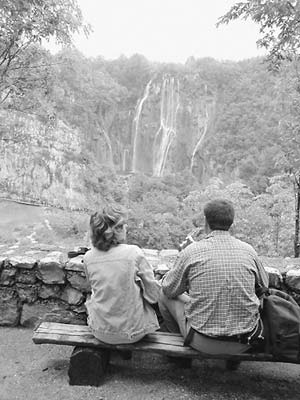
For picnic fixings, there’s a small grocery store at Entrance 1 and another one with a larger selection across road D-1 (use the pedestrian overpass). At the P-3 boat dock, you can buy grilled meat and drinks. Friendly old ladies sell homemade goodies (such as strudel and hunks of cheese) throughout the park, including at Entrance 1.
(See “Plitvice Lakes National Park” map, here.)
Many truck stop-type restaurants, mostly catering to tour buses (and their drivers, who dine like kings in exchange for bringing in so much business), line the highway for miles in both directions from Plitvice. Most are unexciting, but two good options are at the recommended Hotel Degenija and Villa Plitvička Sedra (for details, see “Sleeping in and near Plitvice,” earlier). Many countryside accommodations also have a half-board option; ask about this when you book.
Eating in Bosnia: Adventurous drivers may want to make a short drive across the border, to the town of Bihać (BEE-hahch), Bosnia-Herzegovina, for a bite. This small Bosnian city is about a 30-minute drive from the national park (be sure to bring your passport and the “green card” to take your rental car over the border). If this is your only chance to dip into Bosnia, and you have an evening to kill, it can be a fun option. For more on Bosnian food, see here.
(See “Plitvice Lakes National Park” map, here.)
On the main highway between Zagreb and Plitvice, about 30 minutes before the national park, you’ll pass above, then through, the striking town of Slunj (pronounced “sloon”), which is surrounded by its own little “mini-Plitvice” ecosystem of waterfalls. This can be an enjoyable pit stop, whether or not you eat here. The lower part of the town—buried deep amid all those cascades—is the village of Rastoke (meaning roughly “beautiful water”), which has its share of touristy restaurants. The most elaborate is the complex of Slovin Unique Rastoke, where you can explore a series of canals, waterfalls, canyons, and viewpoints. The grounds also have an old mill, a small “ethno collection” (traditional local furniture, tools, and so on), and a trail down to the Korona River canyon. While you can pay 25 kn to explore (they’ll give you a map), it’s free for those who dine at their restaurant, Pod Rastočkim Krovom (“Under Rastoke’s Roof”). They specialize in trout—you can see their ponds out back—and also have a wide range of other local dishes, including some prepared with grains ground by traditional mills (20-35-kn soups and pastas, 60-80-kn main courses, open long hours daily, Rastoke 25B, mobile 099-215-0907, www.slunj-rastoke.com). Even though the whole complex feels a bit hokey and tour group-oriented (just like everything around Plitvice), it gives you a chance to see some pretty waterfalls.
Getting There: Approaching the town of Slunj from the north, you’ll see Rastoke filling the valley below. After crossing the first bridge, turn right at the Rastoke sign, then park next to—and walk over—the dilapidated old concrete bridge; finally, you turn right and walk down the hill to Slovin Unique Rastoke.
To reach the park, see “Getting to Plitvice,” earlier in this chapter. Moving on from Plitvice is trickier. Buses pass by the park in each direction—northbound (to Zagreb, 2-2.5 hours) and southbound (to coastal destinations such as Split, 4-6 hours).
The park lodge reception desk should have a printout of the specific bus schedule, or you can check at www.autobusni-kolodvor.com (look for “Plitvička Jezera”).
In summer, the best choice is the Prijevoz Knežević express bus (see the sidebar); these buses are designed to zip Plitvice hikers to major destinations, including Zagreb, Zadar, and Split. (In contrast, the regular buses take longer, make several stops en route, and can fill up before even reaching the park.) You can buy tickets for express buses only at the little sales kiosks next to the bus stops at both Plitvice entrances (daily 8:00-17:00, mobile 098-650-757, www.prijevoz-knezevic.hr); for other buses, buy your ticket on board.
There is no bus station at the park—just a low-profile Plitvice Centar bus stop shelter. To reach it from the park, go out to the main road from either Hotel Jezero or Hotel Plitvice, then turn right; the bus stops are just after the pedestrian overpass. The one on the hotel side of the road is for buses headed for the coast (southbound); the stop on the opposite side is for Zagreb (northbound). Try to carefully confirm the bus schedule with the park or hotel staff, then head out to the bus stop and wave down the bus. (It’s easy to confuse public buses with private tour buses, so don’t panic if a bus doesn’t stop for you—look for a bus with your final destination marked in the windshield.)
But here’s the catch: If the bus is full, they won’t stop at Plitvice to pick you up. This is most common on days when the buses are jammed with people headed to or from the coast. For example, on Fridays—when everyone is going from Zagreb to Split—you’re unlikely to have any luck catching a southbound bus at Plitvice after 12:00, as they tend to be full. Similarly, on Sunday afternoons, northbound buses are often full. In general, don’t plan on taking the last bus of the day. One advantage of the Prijevoz Knežević express buses, mentioned above, is that they originate at Plitvice, so they don’t arrive full.
While there’s a chance you’ll miss a bus and have to wait for the next one, bus travel from Plitvice usually works fine...if you’re patient.
Plitvice’s biggest disadvantage is that it’s an hour away from the handy A-1 expressway that connects northern Croatia to the Dalmatian Coast. You have three ways to access this expressway from Plitvice, depending on which direction you’re heading.
Going North: If you’re heading north (to Zagreb or Slovenia), get on the expressway at Karlovac: From Plitvice, drive about one hour north on D-1 to the town of Karlovac, where you can access A-1 northbound. Alternatively, you can take A-1 southbound to A-6, which leads west to Rijeka, Opatija, and Istria (though this route is more boring and only slightly faster than the route via Otočac, next).
Going to Central Croatia: If you’re going to central destinations on the coast, such as Istria, Rijeka, or Opatija, get on the expressway at Otočac. From Plitvice, go south on D-1, then turn west on road #52 to the town of Otočac (about an hour through the mountains from Plitvice to Otočac). After Otočac, you can get on A-1 (north to Zagreb, south to the Dalmatian Coast); or continue west and twist down the mountain road to the seaside town of Senj, on the main coastal road of the Kvarner Gulf. From Senj, it’s about an hour north along the coast to Rijeka, then on to Opatija or Istria.
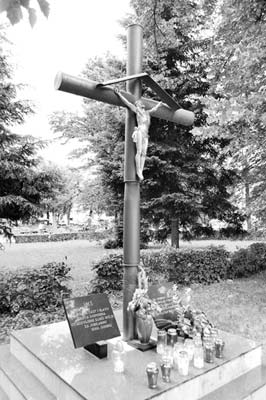
During the recent war, the front line between the Croats and Serbs ran just east of Otočac (OH-toh-chawts), and a few bullet holes still mar the town’s facades. (Watch for minefield warning signs just east of Otočac, but don’t let them make you too nervous: It’s safe to drive here, but not necessarily safe to get out of your car and wander through the fields.) Today Otočac is putting itself back together, and it’s a fine place to drop into a café for a coffee, or pick up some produce at the outdoor market. The Catholic church in the center of town, destroyed in the war but now rebuilt, displays its damaged church bells in a memorial out back. The crucifix nearby is made of old artillery shells.
Also in the churchyard are big white blocks, each one honoring a Croatian hero; notice that a character from Glagolitic script (the ancient Croatian alphabet) is carved in the top of each one. Just up the main street, you’ll come to a fine, manicured park, dominated by a huge monument honoring the lives lost in the fight to create a free Croatian nation. It reads: “In order to make real the vision of a Croatian homeland, they laid upon the altar their dreams, their hopes, and their lives.” Noticing the giant block splintering into four pieces, it’s easy to imagine how this might illustrate the splitting up of the Yugoslav state...and to wonder how local Serbs feel about this relatively new monument.
At the far end of the park is the Orthodox church. Otočac used to be about one-third Serbian, but the Serbs were forced out during the war, and this church fell into disrepair. But, as Otočac and Croatia show signs of healing, about two dozen Serbs have returned to town and reopened their church (for more on the Serbian Orthodox Church, see here).
Going South: If you’re heading south (to Split and the rest of Dalmatia) from Plitvice, catch the expressway at Gornja Ploča. Drive south from Plitvice on D-1, through Korenica, Pećane, and Udbina, then follow signs for the A-1 expressway (and Lovinac) via Kurjak to the Gornja Ploča on-ramp. Once on A-1, you’ll twist south through the giant Sveti Rok tunnel to Dalmatia.